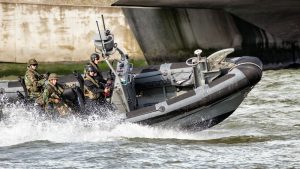Alot of folks have questions about Navy SWCC training. What does it take to become a warfare combat crewman? This isn’t your average office job—it’s about pushing yourself further than you ever thought possible. Are you ready to see what you’re truly capable of? What does Navy SWCC training involve?
Table of Contents:
- Inside Navy SWCC Training: Selection, Physical Demands, and Career Paths
- What is Navy SWCC training?
- Qualifying for Navy SWCC Training
- The PST: It’s More Than Just a Workout
- Navy SWCC training phases
- SWCC Career Paths: More Than Just One Option
- Want to serve but looking for part-time options?
- Want the benefits without breaking a sweat?
- A Want an insider tip on acing the PST?
- Thinking you can outsmart the PST?
- FAQs about Navy SWCC training
- Conclusion
Inside Navy SWCC Training: Selection, Physical Demands, and Career Paths
Becoming a SWCC operator isn’t for everyone. It requires a blend of physical toughness, mental resilience, and a commitment to excellence. This is a career in naval special warfare that requires dedication and the ability to excel in classified locations. If you’re thinking about taking the plunge, this guide is for you.
What is Navy SWCC training?
Navy SWCC (Special Warfare Combatant-Craft Crewman) training develops elite maritime warriors. These guys are the best of the best when it comes to operating and maintaining high-speed boats. This role supports special operations missions and other tasks assigned by the Navy. SWCC operators undergo a rigorous selection process. They also complete demanding physical training that pushes them beyond their limits.
Qualifying for Navy SWCC Training
Think you have what it takes? Here are the requirements:
- Be a U.S. Citizen.
- Age: 18-30 years old or less (17 with parental permission; waivers are possible).
- High School Graduate (or meet the High Performance Predictor Profile (HP3) criteria). Be proficient in English (reading, writing, speaking, understanding).
- No history of substance abuse, felony convictions, or pending lawsuits.
- Eyesight Requirements: Uncorrected vision can be no worse than 20/200 in each eye. Both eyes must be correctable to 20/20, with no color blindness. You can read more about Navy requirements on the Navy Recruiting Command page.
- Minimum ASVAB Score: VE+AR = 104, MC=50.
- Pass the SWCC Physical Screening Test (PST) Minimum Requirements.
The PST: It’s More Than Just a Workout
The PST assesses your physical readiness for a career as a combat crewman. Here’s a breakdown of what you need to conquer:
| PST | SWCC Minimum |
| SWIM 500 YDS. (side stroke or breaststroke) | 13:00 min |
| Rest 10 minutes | |
| PUSH-UPS (within 2 minutes) | 42 |
| Rest 2 minutes | |
| SIT-UPS (within 2 minutes) | 50 |
| Rest 2 minutes | |
| PULL-UPS (no time limit) | 6 |
| Rest 10 minutes | |
| 1.5 MILE RUN | 12:30 min |
Navy SWCC training phases
Once you’re in, you’ll go through various phases:
- Naval Special Warfare Orientation (7 weeks): Held in Coronado, CA. Expect lots of physical and psychological preparation. They will prepare you for the challenges of becoming a SWCC operator.
- Basic SWCC Training (7 weeks): Also in Coronado, CA. This phase tests you mentally and physically to determine if you’ve got the grit to continue. This is where you put your ordnance disposal skills to the test.
- Basic Crewmember Training (BCT) (7 weeks): In Coronado, CA. You will gain experience in surface warfare and reconnaissance missions.
- Crewman Qualification Training (CQT) (13 weeks): In sunny Coronado, CA. Here you will become comfortable working alongside special operations personnel.
You’re not just learning to drive boats—it’s about becoming part of an elite brotherhood. You will learn to think like a warrior and develop skills for high-pressure situations. Specialized training, coupled with work experience gained, can also pave the way for valuable credentialing and occupational opportunities in similar fields. The credentialing and occupational opportunities gained through this experience are unmatched. The experience will help advance your education and can potentially translate to college credits. Navy training in the NSW field, specifically, can potentially translate to college credits through the American Council on Education.
SWCC Career Paths: More Than Just One Option
As an aspiring special warfare combat crewman, you can take many career paths. Here are a few examples:
- Special Boat Team TWELVE (SBT-12)
- Special Boat Team TWENTY (SBT-20)
- Special Boat Team TWENTY-TWO (SBT-22)
These teams have various specialties. You’ll have the chance to hone your skills and contribute where it matters most. You may even have the opportunity to learn about data rates and other technical skills.

Want to serve but looking for part-time options?
There are none. SWCC is not a part-time gig; this is a full-on, dedicated service. Training requires a great deal of time to master the necessary skills. But don’t despair. You can explore other Navy careers and see how your skills might fit into their branches. You can even become an Every Sailor A Recruiter by signing up for their program.
Want the benefits without breaking a sweat?
Who doesn’t, right? Navy SWCC training requires dedication and hard work. You’ll earn every bit of those benefits, and the sense of accomplishment is incredible.
Want an insider tip on acing the PST?
Show up ready. SWCC instructors appreciate those who embrace the challenge from day one. It shows mental fortitude, which is important in high-pressure situations. Oh, and hydrate or die. No, seriously—your body needs all the fluids it can get during those intense workouts. Trust me.
Are you thinking you can outsmart the PST?
You won’t find shortcuts to becoming a SWCC operator. Consistency is king. If you put in the work consistently, your body can handle whatever is thrown at it. Plus, Navy chow is actually pretty good. It gives you the fuel you need without sacrificing taste, which is crucial for staying motivated during training. Are you curious about joining but need financial assistance for education? Check out the Navy’s enlistment bonuses; you might be surprised by what they offer.
